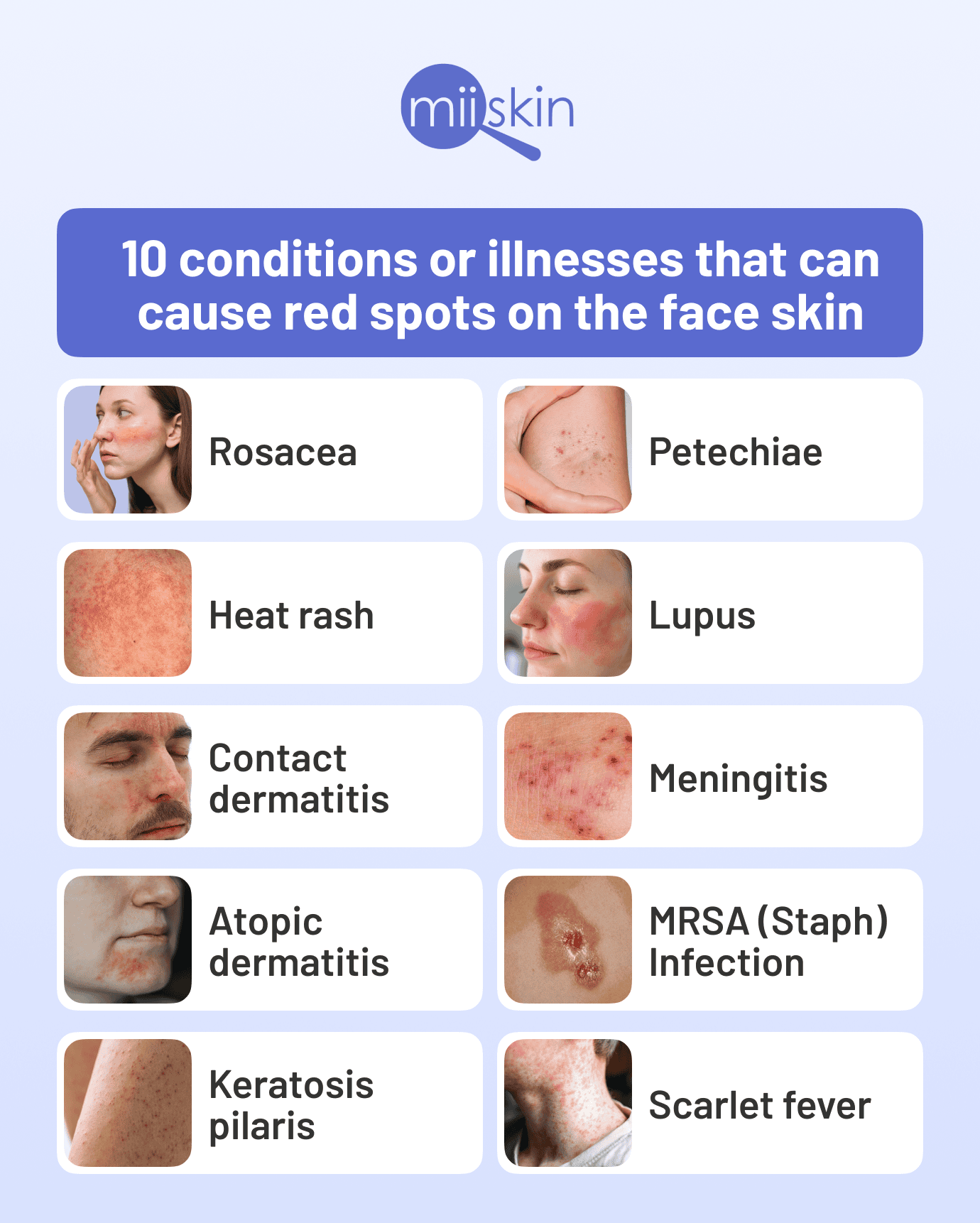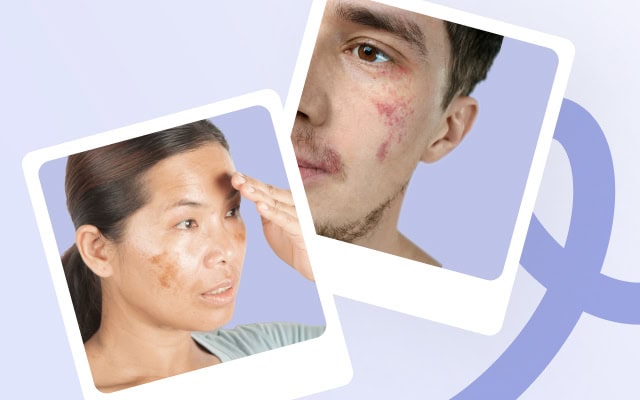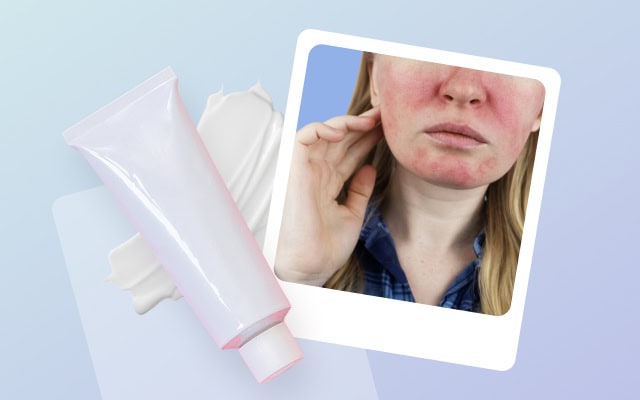What can cause red spots on face skin?
Dr. Carolina Fernandez Quiroga, board-certified dermatologist, talks about 10 conditions or illnesses that can cause red spots on the face and body.
Table of Content:
Rosacea | Heat Rash | Contact dermatitis | Eczema | Keratosis pilaris | Petechiae | Lupus | Meningitis | MRSA | Scarlet fever | FAQ
Our commitment to producing high-quality content:
The information presented in this article is based on scientific research and the professional advice of our Content Medical Reviewers, who are experts in the field of Dermatology. How we write our content →
Red spots on the face can be a source of concern for many, as they can indicate a variety of underlying conditions. From minor irritations to serious health issues, understanding the potential causes of these red spots is crucial for proper diagnosis and treatment. This article explores the common and uncommon factors that can lead to red spots on the facial skin, helping you identify possible causes and determine when to seek medical advice.

How to get treatment for red spots on the skin?
If the red spots on your skin do not disappear after a few days or if you are worried in regards to what may cause them, you can have a photo-consultation with a board-certified dermatologist via Miiskin. You just need to take some high-resolution photos of your skin, answer the questions, enter your credit card details and pay for the consultation. The dermatologists affiliated with Miiskin usually reply in 24 hours, but it can take up to 48 hours for them to respond. They will guide you on how to proceed.
Secure, confidential, and reviewed by board-certified dermatologists.
Rosacea
Rosacea primarily affects the face, causing persistent redness, visible blood vessels, and sometimes acne-like bumps. It often appears on the cheeks, nose, forehead, and chin, and can be triggered by various environmental and lifestyle factors.
Treatment for rosacea
Treatment focuses on reducing symptoms and preventing flare-ups. Topical treatments and oral antibiotics can be effective1.
OTC Medications
- Gentle skincare products
- Sunscreen
Prescription Medications
- Topical treatments like metronidazole, azelaic acid, or brimonidine
- Oral antibiotics such as doxycycline for more severe cases
- Laser therapy to reduce visible blood vessels
Heat rashes
Heat rash (also known as miliaria) is common in areas where sweat accumulates, but can also occur on the face, especially in hot, humid conditions or during physical activity. It manifests as small, red, itchy bumps caused by blocked sweat ducts2.
Treatment for heat rashes
Treatment focuses on cooling the skin and reducing sweating. Staying in a cool, air-conditioned environment, wearing loose, breathable clothing, and applying cold compresses can help.
OTC medications
- Calamine lotion
- Hydrocortisone cream
Prescription medications
In severe cases, a dermatologist may prescribe stronger topical treatments to reduce inflammation and discomfort.
Contact dermatitis
Contact dermatitis is common on the face due to exposure to allergens or irritants in skin care products, cosmetics, or environmental factors. It causes red, itchy, and sometimes blistering spots where the skin has come into contact with the offending substance.
Treatment for contact dermatitis
Treatment involves identifying and avoiding the allergen or irritant. Low-potency corticosteroids on the face or topical tacrolimus can reduce inflammation and itching3.
OTC Medications
- Hydrocortisone cream
- Oral antihistamines
Prescription Medications
- Oral antihistamines for severe reactions
Atopic dermatitis (Eczema)
Atopic dermatitis, or eczema, frequently affects the face, particularly in infants and young children, but can also be seen in adults. It is characterized by red, itchy, and inflamed patches resulting from a chronic condition.
Treatment for eczema (atopic dermatitis)
Treatment aims to reduce inflammation and relieve itching. This includes using topical corticosteroids or calcineurin inhibitors, applying moisturizers regularly, and avoiding known triggers4.
OTC Medications
- Hydrocortisone cream
- Moisturizers
Prescription Medications
- Topical corticosteroids (stronger formulations)
- Topical calcineurin inhibitors
- Oral corticosteroids for severe cases
- Biologics
Secure, confidential, and reviewed by board-certified dermatologists.
Keratosis pilaris
Keratosis pilaris is typically found on the upper arms, thighs, and buttocks, but it can also appear on the cheeks, especially in children and teenagers. It presents as small, rough, red or flesh-colored bumps that can be mistaken for acne. While keratosis pilaris is harmless, treatments can improve the skin’s appearance.
Treatment for keratosis pilaris
Regular exfoliation with a gentle scrub or chemical exfoliants like alpha hydroxy acids (AHAs) and moisturizing with lotions containing urea or lactic acid can help smooth the skin5.
OTC Medications
- Lotions containing urea or lactic acid in a low percentage
- Chemical exfoliants such alpha hydroxy acids (AHAs)
Prescription medications
- Topical retinoids prescribed by a dermatologist for persistent cases
Petechiae
Petechiae are small, pinpoint, round spots that appear on the skin due to bleeding under the skin. These spots are typically red, purple, or brown and do not blanch (turn white) when pressed. Petechiae can occur anywhere on the body, including the face, and in many cases it will resolve on its own after a few days, but it can also be a sign of various underlying medical conditions, ranging from minor to serious.
Petechiae can be caused by physical strain from severe coughing, vomiting, or heavy lifting, which increases pressure in the capillaries. Infections such as viral, bacterial, or fungal diseases, like meningitis and endocarditis, can also lead to petechiae. Certain medications, especially anticoagulants or those affecting platelet function, can cause these spots. Additionally, medical conditions like blood disorders (thrombocytopenia or leukemia), vasculitis, and autoimmune diseases can result in petechiae. Trauma or injury to the skin can cause localized petechiae.
Although petechiae does not cause symptoms, it is often associated with an underlying condition, and can be accompanied by fever, fatigue, bruising, bleeding gums or, nosebleeds, joint or muscle pain.
Treatment for petechiae
Seek medical attention as soon as possible if petechiae spreads rapidly or is accompanied by other concerning symptoms such as high fever, difficulty breathing, or severe pain. Prompt evaluation can help identify serious underlying conditions that may require immediate treatment. The treatment for petechiae focuses on addressing the underlying cause6.
Treatments depend on the cause, which is why it is always important to consult a doctor. Among the medications that are usually prescribed according to the cause are:
- Antibiotics for bacterial infections
- Corticosteroids for inflammatory conditions
- Platelet transfusions for blood disorders
- Other specific treatments depending on the underlying cause
Lupus
Lupus is a chronic autoimmune disease that can cause inflammation and damage to various parts of the body, including the skin, joints, kidneys, heart, lungs, and brain. Although it can affect everyone, it is more common in women between the ages of 15 – 45 years of age. Lupus can cause a characteristic butterfly-shaped rash across the cheeks and bridge of the nose. This rash is often red and may be either flat or raised. Lupus can also cause other types of rashes and lesions on the face and other parts of the body, often triggered or worsened by sun exposure.
Treatment of lupus
Lupus requires long-term management and treatment tailored to the individual’s symptoms and severity of the disease. Although it’s a chronic condition and there’s no definitive treatment for lupus, treatments can help control symptoms and prevent flare-ups. This way, it’s possible to halt the progression of the disease. That’s why it’s important to consult a doctor and follow up with medical care7.
- NSAIDs (such as ibuprofen, naproxen) for pain and inflammation
- Sunscreens to protect the skin from UV light
- Topical corticosteroids for skin rashes
- Oral corticosteroids to reduce inflammation
- Antimalarial drugs to manage skin and joint symptoms
- Immunosuppressive drugs (such as methotrexate, azathioprine)
- Biologics for severe cases8
Secure, confidential, and reviewed by board-certified dermatologists.
Meningitis
Meningitis is a serious condition that causes inflammation of the membranes surrounding the brain and spinal cord. While it primarily affects the central nervous system, it can also cause a distinctive skin rash that appears as small, red or purple spots (petechiae) on the face, as well as other parts of the body.
Meningitis can affect individuals of all ages, including adults. While the condition is often more common and severe in infants and small children, adults can also develop meningitis and its associated rash. The presence of skin lesions in meningitis underscores its medical significance rather than cosmetic concern. Meningitis is a serious condition affecting the central nervous system. While skin lesions may be visible, their importance lies in the risks they pose to the patient’s health and well-being, rather than their cosmetic appearance9.
Treatment for meningitis
Meningitis is a medical emergency and requires immediate treatment. The treatment depends on the cause of meningitis (bacterial, viral, or fungal).
- Antibiotics for bacterial meningitis
- Antiviral medications for viral meningitis
- Antifungal medications for fungal meningitis
- Corticosteroids to reduce inflammation
- Hospitalization and supportive care10
MRSA (Staph) Infection
Methicillin-resistant Staphylococcus aureus (MRSA) is a type of staph bacterial infection that is resistant to many commonly used antibiotics. It can cause a variety of infections, ranging from mild skin conditions to more severe infections that can affect the bloodstream, lungs, or other parts of the body. MRSA infections on the skin can appear as red, swollen, and painful bumps or boils, often with pus or other drainage. These bumps can resemble pimples or spider bites and may rapidly progress to form deep abscesses. If left untreated, MRSA can spread to other areas of the body and cause more severe health issues.
Treatment for MRSA
MRSA infections require prompt medical attention. Treatment involves draining abscesses and using antibiotics that the MRSA strain is not resistant to.
- Antibiotics such as vancomycin, clindamycin, or linezolid
- Topical antibiotics like mupirocin for minor skin infections
- Incision and drainage of abscesses by a healthcare professional11
Scarlet fever
Scarlet fever (also known as scarlatina) is an infectious disease caused by the Streptococcus A bacteria, the same bacteria responsible for strep throat. It is most common in children between the ages of 5 and 15 but can also affect adults. Scarlet fever is characterized by a distinctive red rash, fever, and sore throat. The typical rash of scarlet fever appears as small red spots that may be difficult to distinguish at first. These spots tend to merge and form larger red areas resembling a sunburn. The rash may be most noticeable in the armpits, groin, and around the neck, and it can spread to the trunk and limbs. The skin may feel rough to the touch and may be accompanied by itching. The rash often causes the face to appear flushed with a pale ring around the mouth. Additionally, the tongue may develop a red and bumpy appearance, known as “strawberry tongue.”
Treatment for scarlet fever
Scarlet fever is treated with antibiotics to eliminate the infection and prevent complications.
- Oral antibiotics such as penicillin or amoxicillin
- Pain relievers such as acetaminophen or ibuprofen to reduce fever and discomfort12
When to seek medical help?
Anyone with signs of an infection or unexpected skin symptoms should seek medical advice, especially if a rash does not improve despite using OTC or at-home treatments. It is important to consult a doctor if there are accompanying symptoms such as fever, severe head or neck pain, joint pain or stiffness, difficulty breathing, frequent vomiting or diarrhea, confusion, or dizziness.
When to seek emergency medical help?
Immediate medical attention is necessary if a rash is accompanied by symptoms such as a rash covering the entire body, fever, blisters or open wounds, difficulty breathing, speaking, or swallowing, swelling of the face, eyes, or lips, stiff neck, light sensitivity, seizures, or drowsiness or unresponsiveness. Immediate attention is also needed for any new rashes that are painful and affect the eyes, inside of the mouth, or genitalia.
Secure, confidential, and reviewed by board-certified dermatologists.
Frequently asked questions about red dots on the skin
Why do red spots appear on the skin?
Dr. Carolina Fernandez says that red spots can appear on the skin for various reasons, including infections, allergic reactions, heat, physical irritation, and underlying medical conditions such as blood disorders or autoimmune diseases. Each cause may present distinct characteristics, making it important to identify the underlying factor to determine the appropriate treatment.
Can red spots on the skin appear due to stress?
Dr. Fernandez says that indeed, red spots on the skin can appear due to stress. Stress can trigger a variety of skin conditions, including hives, eczema, and psoriasis, which can manifest as red spots or patches. Stress-induced changes in hormone levels and immune function can exacerbate these skin issues, leading to visible red spots.
What do red spots from stress look like?
Dr. Fernandez says that stress-related red spots often appear as hives (urticaria), which are raised, red, itchy welts on the skin. These spots can vary in size and may come and go, often appearing suddenly during periods of high stress. Managing stress through relaxation techniques and lifestyle changes can help reduce these symptoms.
What are red spots on the skin that don’t itch?
Dr. Fernandez says that red spots on the skin that don’t itch can be caused by conditions such as petechiae, which are small, pinpoint hemorrhages under the skin. They can also result from non-itchy rashes due to medication side effects, certain infections, or vascular issues. It’s important to consult a healthcare provider to identify the cause.
Can COVID-19 cause red spots on the skin?
Dr. Fernandez says that COVID-19 can cause red spots on the skin. Some patients with COVID-19 have reported various skin manifestations, including red rashes, hives, and “COVID toes,” which are red or purple spots on the toes. These skin symptoms are thought to be related to the body’s immune response to the virus.
Can allergies cause red spots on the skin?
Dr. Fernandez says allergies can cause red spots on the skin. Allergic reactions can result in conditions like urticaria (hives), contact dermatitis, and atopic dermatitis, all of which can present as red, itchy spots or patches. Common allergens include certain foods, medications, insect bites, and contact with irritants.
What are red spots on the skin of children?
Dr. Fernandez says that red spots on the skin of children can be due to a variety of causes, such as viral infections (such as chickenpox or measles), bacterial infections (scarlet fever), allergic reactions, and common skin conditions like eczema. Identifying the cause is crucial for proper treatment and management.
What are red spots on the skin that look like moles?
Dr. Fernandez says that red spots on the skin that look like moles could be cherry angiomas, which are benign (non-cancerous) vascular growths. They are usually small, red, and slightly raised. While typically harmless, any new or changing skin lesions should be evaluated by a dermatologist to rule out other conditions.
Can lupus cause red spots on the skin?
Dr. Fernandez says that lupus can cause red spots on the skin. One of the hallmark signs of lupus is a butterfly-shaped rash across the cheeks and bridge of the nose. Lupus can also cause other types of rashes and red spots due to inflammation and autoimmune activity affecting the skin.
What are the red spots on my baby’s skin?
Dr. Fernandez says that red spots on a baby’s skin can be caused by various conditions, such as newborn rashes (erythema toxicum), heat rash, allergic reactions, or infections. It’s important to monitor the baby’s symptoms and consult a pediatrician to determine the cause and appropriate treatment if necessary.
What could red circular spots on the skin be?
Dr. Fernandez says that red circular spots on the skin can be indicative of several conditions. The two more common and frequent causes are ringworm or nummular eczema, both of these conditions create ring-shaped, red, scaly patches.
Secure, confidential, and reviewed by board-certified dermatologists.
What do red spots on the skin that look like burns mean?
Dr. Fernandez says that red spots on the skin that look like burns could indicate a severe allergic reaction or a condition like erythema multiforme. This condition often appears as red patches that resemble burns and can be triggered by infections, medications, or other factors. Another possibility is Stevens-Johnson syndrome, a serious disorder that causes a burn-like rash and requires immediate medical attention.
What could red spots on the skin that itch be?
Red spots on the skin that itch are often caused by allergic reactions, such as hives (urticaria), which appear suddenly and can be triggered by food, medications, or environmental factors. Other causes include eczema, an inflammatory skin condition, and insect bites, which typically cause localized itching and redness.
What do red spots on the skin with itching mean?
Red spots on the skin with itching usually indicate an inflammatory or allergic reaction. Conditions like eczema, contact dermatitis, and hives are common causes. These spots can appear due to exposure to allergens, irritants, or environmental factors, leading to redness and persistent itching.
Can HIV cause red spots on the skin?
Dr. Fernandez says that HIV can cause red spots on the skin. HIV-related skin conditions include acute retroviral syndrome, which can lead to a red, maculopapular rash. Additionally, individuals with HIV are more prone to infections and skin conditions. it’s important to note that HIV and AIDS are not the same. A person receiving appropriate medical treatment for HIV can lead a normal life, and skin spots are more common in the early stages of infection. Other manifestations, such as Kaposi’s sarcoma, a type of cancer that appears as red or purple lesions on the skin, are typically associated with an advanced stage of the disease when treatment is not received and AIDS develops.
What could a red spot on the skin that causes pain be?
A red spot on the skin that causes pain could be a sign of an infection or an inflammatory condition. For instance, an abscess or boil, caused by a bacterial infection, can appear as a painful, red bump. Cellulitis, a bacterial skin infection, also presents as a painful, red, swollen area and requires prompt medical treatment.
What do red spots on the skin of the legs mean?
Red spots on the skin of the legs can result from various causes, such as insect bites, allergic reactions, or conditions like folliculitis, where hair follicles become inflamed. Other possibilities include vascular issues like petechiae or purpura, which are small red spots caused by bleeding under the skin, often linked to underlying medical conditions.
What is the best cream for red spots on the skin?
Dr. Fernandez says that the best cream for red spots on the skin depends on the underlying cause. That is why it is always important to consult a dermatologist first to evaluate the cause of a red spot on the skin. That being said, hydrocortisone cream is commonly used to reduce inflammation and itching associated with allergic reactions and eczema. For fungal infections, antifungal creams like clotrimazole or miconazole are effective.
How do you know if a red spot is bad?
Dr. Fernandez says that a red spot may be considered “bad” if it changes in size, shape, or color, becomes painful, bleeds, or does not heal over time. If accompanied by other symptoms such as fever, swelling, or difficulty breathing, it may indicate a serious condition. It is important to seek medical evaluation to determine the cause and appropriate treatment.
What do red spots from poor circulation look like?
Dr. Fernandez says that red spots from poor circulation often appear as petechiae or purpura, which are small, red or purple spots caused by bleeding under the skin. These spots may be accompanied by swelling, pain, or a feeling of heaviness in the affected area. It’s important to note that red spots on the skin can be a sign of various circulatory disorders, including venous insufficiency, arterial insufficiency, vasculitis, or other underlying medical conditions.
Key points of the article
Definition: Red spots on the face can indicate a variety of underlying conditions, from minor irritations to serious health problems.
Common causes: Causes can include rosacea, heat rash, contact dermatitis, atopic dermatitis (eczema), keratosis pilaris, petechiae, lupus, meningitis, MRSA infection, and scarlet fever.
General treatment: Depending on the cause, treatments can vary from using gentle skincare products and sunscreens to topical treatments, oral antibiotics, calamine lotion, and antihistamines.
When to seek medical help: It is crucial to seek medical attention if red spots do not improve with home treatments or if they are accompanied by severe symptoms such as fever, difficulty breathing, severe pain, or any other concerning symptoms.
Are you worried about red spots on your skin? Consult an online dermatologist.
Lee éste artículo en Español 10 enferemedades que causan manchas rojas en la piel.
Article References:
https://www.ncbi.nlm.nih.gov/pmc/articles/PMC5134688/
https://www.ncbi.nlm.nih.gov/books/NBK537176/
https://www.ncbi.nlm.nih.gov/books/NBK459230/
https://www.ncbi.nlm.nih.gov/books/NBK538209/
https://www.ncbi.nlm.nih.gov/books/NBK546708/
https://www.ncbi.nlm.nih.gov/books/NBK482331/
https://www.mayoclinic.org/diseases-conditions/lupus/symptoms-causes/syc-20365789
https://www.mayoclinic.org/diseases-conditions/lupus/diagnosis-treatment/drc-20365790
https://www.ncbi.nlm.nih.gov/books/NBK459360/
https://www.ncbi.nlm.nih.gov/books/NBK459360/
https://www.ncbi.nlm.nih.gov/books/NBK482221/
https://www.ncbi.nlm.nih.gov/books/NBK507889/
Skin conditions and treatments
Articles reviewed by dermatologists
Facial treatment for seborrheic dermatitis
How to get rid of rosacea permanently?
How to calm a rosacea flare-up fast?
Spongiotic dermatitis: What is it and what is the best treatment?
A dermatologist’s guide to psoriasis medication





 Still dealing with skin issues? Get expert help from home.
Still dealing with skin issues? Get expert help from home.
